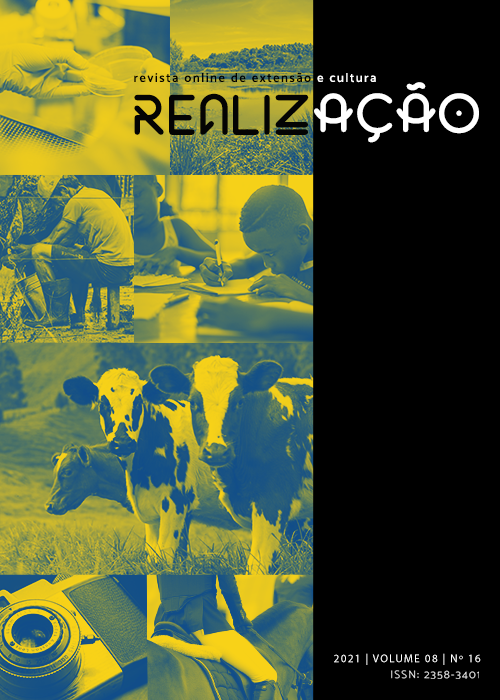Internationalization of Brazilian Sign Language: experience report
DOI:
https://doi.org/10.30612/realizacao.v8i16.15449Keywords:
Libras, Extension, Deaf people, L2 learning, MOOCAbstract
This work has the objective of describing some aspects that were experienced by the authors when developing the Extension Program entitled "Brazilian Sign Language: Learn the Basics". The project had as its main objective the internationalization of Brazilian Sign Language (Libras), being constituted as a Libras course that was offered in English, using the Moodle platform, being a five-week duration course. The project was coordinated by the co-author of this work and the author was the course's tutor. Throughout this work we will present a more detailed description of the Project, how did the authors work in the Project and the issues that were arised throughout the course which are: i) Libras internationalization, ii) the scope and outrech of the course, iii) experiences of producing content and iv) interaction with students through the Moodle platform. At first, it is possible to report that the course, in addition to presenting the opportunity for English speakers to learn Libras, has also generated translated material from Libras directly into English, being a meaninful source of dissemination and visibility of the language in other countries. Furthermore, this type of initiave can generate exchanges between university/students/researchers from the same area, contributing to the internationalization of the content produced in Brazilian universities, and in the specific case of the project that is reported here, praising the important role that extension plays in promoting knowledge about Brazilian Sign Language.
Downloads
References
PICONI, Larissa Bassi. A educação de surdos como uma importante esfera das Políticas Linguísticas para a Língua Brasileira de Sinais: o decreto nº 5.626/05 em foco. Revista Educação Especial, [S.L.], v. 32, p. 89, 22 out. 2019. Universidade Federal de Santa Maria.
BRASIL. Ministério da Educação. Secretaria de Educação Especial. Decreto Nº 5.626, de 22 de dezembro de 2005. Regulamenta a Lei Nº 10.436, de 24 de abril de 2002. Acesso em 30 maio 2013.
BRASIL. Ministério da Educação. Secretaria de Educação Especial. Lei Nº. 10.436, de 24 de abril de 2002. Dispõe sobre a Língua Brasileira de Sinais– Libras e dá outras providências. Acesso em 30 maio 2013.
GESSER, Audrei. LIBRAS? Que Língua é Essa. Porto Alegre: Parábola, 2009.
CAPOVILLA, F. C.; RAPHAEL, W. D.; MAURÍCIO, A. C. Dicionário Ilustrado Trilíngue da Língua Brasileira de Sinais (Libras). 3ª ed. Volumes 1 e 2. São Paulo: Edusp, 2013.
FELIPE, T. A. LIBRAS em Contexto. Curso Básico. Rio de Janeiro: MEC/FENEIS, 2007.
PIMENTA, N. Curso de Língua de Sinais, vol. 1. Rio de Janeiro: LSB Vídeo, 2007.
HÜNEMEIER, A.P. et al. As contribuições da extensão para a formação pessoal e profissional de acadêmicos bolsistas do projeto redes interdisciplinares. Destaques Acadêmicos, v.8, p.21 - 37, 2017.
Downloads
Published
How to Cite
Issue
Section
License
Copyright (c) 2022 José Ednilson Gomes de Souza Júnior, Vitória Tassara Costa Silva

This work is licensed under a Creative Commons Attribution-NonCommercial-ShareAlike 4.0 International License.
Autores que publicam nesta revista aceitam as normas de publicação, bem como, concordam com os seguintes termos:
(a) O Conselho Editorial se reserva ao direito de efetuar, nos originais, alterações da Língua portuguesa para se manter o padrão culto da língua, respeitando, porém, o estilo dos autores.
(b) Autores mantêm os direitos autorais e concedem à revista o direito de primeira publicação, com o trabalho simultaneamente licenciado sob a Creative Commons Atribuição-NãoComercial-CompartilhaIgual 4.0 Internacional que permite: Compartilhar — copiar e redistribuir o material em qualquer suporte ou formato e Adaptar — remixar, transformar, e criar a partir do material. A Creative Commons Atribuição-NãoComercial-CompartilhaIgual 4.0 Internacional considera os termos seguintes:
- Atribuição — Você deve dar o crédito apropriado, prover um link para a licença e indicar se mudanças foram feitas. Você deve fazê-lo em qualquer circunstância razoável, mas de nenhuma maneira que sugira que o licenciante apoia você ou o seu uso.
- NãoComercial — Você não pode usar o material para fins comerciais.
- CompartilhaIgual — Se você remixar, transformar, ou criar a partir do material, tem de distribuir as suas contribuições sob a mesma licença que o original.
- Sem restrições adicionais — Você não pode aplicar termos jurídicos ou medidas de caráter tecnológico que restrinjam legalmente outros de fazerem algo que a licença permita.


